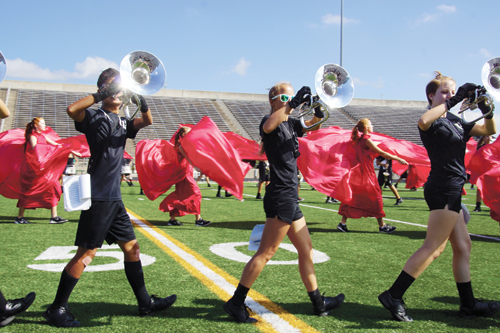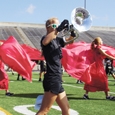
In modern marching band shows, tempos are getting faster every year, and the variations (ritardando, accelerando, sudden changes) are also increasing. These make foot technique and foot timing more difficult, but the best technique in the world does not matter if it is not perfectly together. It is essential to be specific with students about how their marching technique looks and exacting about when and how they land their foot on the ground.
Start at the Beginning
On day one we first work to get students’ feet in time, moving across the field with a metronome giving a steady beat. To keep things interesting, we occasionally move to music instead. The aim of this – and we do a lot of it – is to get the legs and feet moving in time. We prefer a macro-to-micro approach in marching instruction. At times people go from micro to macro and give too much attention to the tiniest details without making sure students can actually move their feet in time.
Define and Demonstrate
The next step, which also happens the first day, is to talk about the kind of motion we want students to use. We use straight-leg technique and define the leg movement for both forward and backward marching as a pendulum motion that initiates from the hip, which is common in this marching style. We do not talk about their legs staying stiff or straight; we emphasize moving from the hip. Once we get everyone moving in time, we talk about how that motion moves and where it moves from. We use the words “pendulum motion” quite a bit. This is when knowing how to demonstrate the technique is important. Once you know technique and can properly demonstrate it, you can relate to the students what it feels like and looks like to be correct.. I know exactly how it feels to move from my hip.
I firmly believe that, as with any physical skill, marching technique should be properly demonstrated; the instructors practice it until it looks right. We have some younger staff members who are fantastic marchers, and one of my best teaching tools is for the students to see instructors move across the field. Musicians pick up jazz style from listening, and they will learn marching technique through watching people do it well.
Correct Steps
Once we get students moving in time and from the hip rather than the knee, we invest a great deal of time on the relationship of the foot to the ground, because that can affect whether the legs move correctly. When moving the leg from the hip during a forward march, the back edge of the heel hits the ground on the beat.
In dance this is referred to as a flexed position, meaning the foot and leg make an L shape, as opposed to a pointed position, where they are a straight line. In bent-leg technique, the foot would go into point position before it hit the ground, but straight-leg technique keeps the foot almost exclusively in a flex position, so we talk about that frequently.
As the front foot hits the ground, the back leg should be stretched and extended, creating an equal weight distribution between both feet. If the students fall all the way forward on the front foot, the back leg will bend and release incorrectly, so it is necessary to talk about stretching the back leg as the front foot lands.
Students should release the back foot immediately after the front foot lands, quickly pulling the back heel as close to the ground as they can. As we hone in on cleaning the show, students work on releasing the entire platform of the foot (the tip of the toes to the top of the arch) at once. They like to roll the back foot up to the big toe before releasing it from the ground, but this causes the timing to be a little slow. It also creates a big bend in the back knee, knocking the back leg out of the correct shape.
When the back leg pulls even with the front leg, the heel and toe should be equidistant from the ground. As students swing through, the motion stays the same, and they land with the edge of the right heel, again making sure that when the front heel lands, the back leg stays long and extended.
Marching Backward
When marching backward, some people have students stay up on their toes, but we land the platform of the foot. I do not want heels to touch the ground, but enough of the foot should land on the ground for students to keep balance while the motion and shape of the leg look correct.
Solving Problems
When people teach straight-leg technique, they often focus on getting the legs as straight as possible, but this causes students to be rigid and bounce up and down. This has an adverse effect on their playing. It is better to focus on the relationship of the foot to the ground. There is no need to emphasize a straight leg; the leg will swing from the hip naturally as long as the heel is down as the foot passes through. To combat stiff legs, I have students take a step forward, keeping the heel low to the ground. This forces them to use motion from the hip without stiffening the leg. It is impossible to make the heel go forward without motion from the hip. People talk about keeping the leg straight when moving from the hip, but if they will just focus on keeping the heel as low as possible, a relaxed hip motion and straight leg occur naturally without hyperextending the knee. We never want students to pull the knee back or lock their legs, because that can create a new set of problems.
Students often want to initiate their motion from the knee. This is easy to spot; when it happens the heel pulls up before the leg moves forward. We emphasize keeping the heel low and gliding forward rather than coming up and pushing forward.
If it becomes absolutely necessary to discuss the leg, the term is always “relaxed, straight leg.” The term for our marching style is straight-leg technique, but given the difficulties that arise when students focus on the leg, I avoid calling it that in front of them. One of the most difficult things about teaching straight-leg technique is its name.
For marching technique to be great, it has to happen in time, it has to be well-defined enough that it can be unified from player to player, and the technique choice cannot have an adverse effect on the music. It is easy to lose focus on any one of these in favor of the other two, but the progression from macro (get the feet in time with a metronome while going across the field) into micro (learning how the heel relates to the ground as the legs pass) usually has worked well. The staff and student leaders work to give simple and quick information, and even more importantly, provide correct examples of what we want to see. This, plus ample repetition, will get students moving at exactly the same time.






